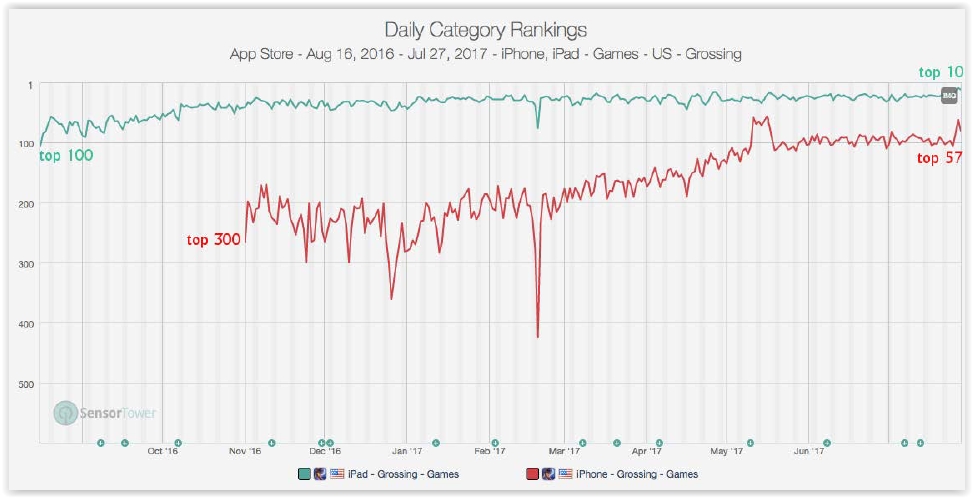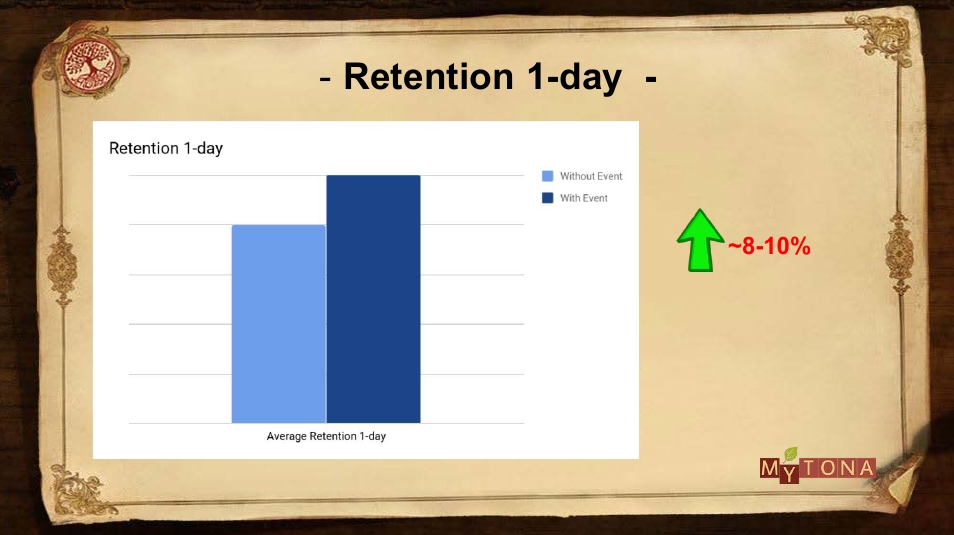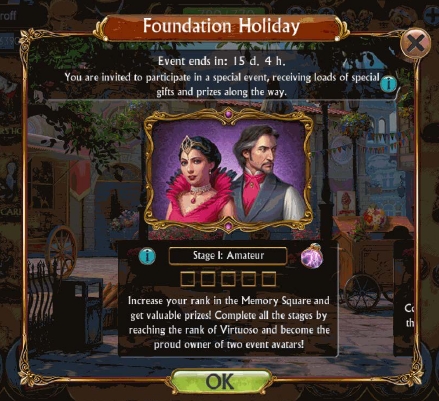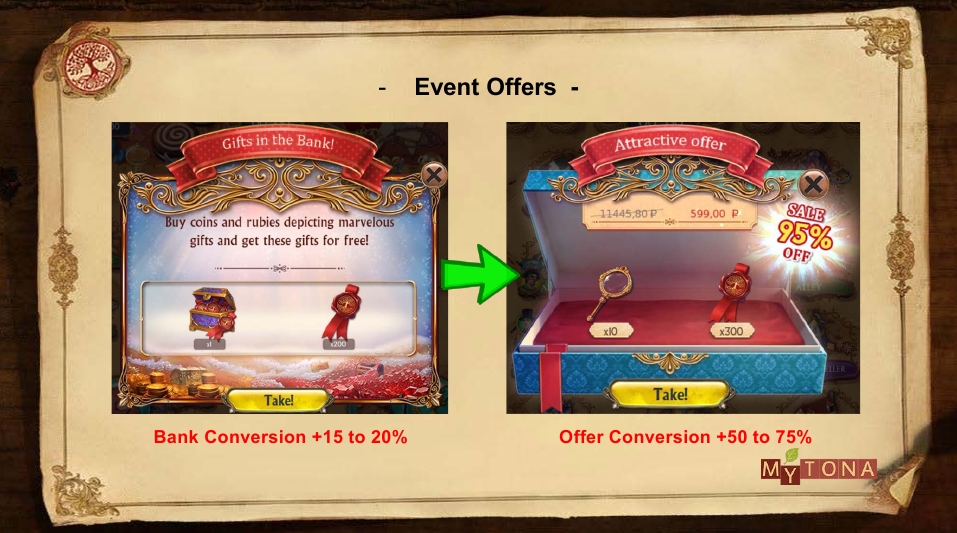Working on an event for a casual game using the example of Seekers Notes
How to improve in–game events and increase user involvement in the project with their help, – Igor Petrov, Director of Game Design at MyTona, told on the example of Seekers Notes: Hidden Mystery.
The report was read at White Nights Moscow 2017. We have prepared a printed version of the speech.

Igor Petrov
I’ll start with a few words about the project. Seekers Notes: Hidden Mystery is a mobile game in the hidden object genre.
It was published by us in 2015. One of her latest achievements is the 9th place in the list of the most earning iPad games in America.
In the third quarter of 2017, we occupied top positions in Western markets on the iPad and iPhone. And now it is considered the most successful hidden-object game in America.

The graph shows a steady increase in the game’s performance since its release in the United States. iPad is marked in green, iPhone is marked in red. The growth was quite long, but stable.
Event and its structure
The Seekers Notes event is a special event that offers unique content and unique rewards for a certain period of time.
This model of “disappearing” content has recently become very popular. And not only in games.
For example, Instagram implemented the Stories feature a year ago. It works on the principle of Snapchat and allows users to temporarily see certain content that is erased after a day.
If Instagram users used to go there 2-3 times a day, now they do it much more often, because there is some content for them that will be unavailable after a certain time.
It also works in games. After the introduction of temporary events, our players also started coming in more often.
The structure of events can be different. We have it based on the fact that in Seekers Notes the invent lasts 28 days. After the end of one event, the next one is launched for the same period.
For each event, we develop one “event” location that the player must explore. We provide him with 30 unique quests, as well as 3 pages in the “Seeker’s Diary”, unique quest rewards and time-limited offers.
We compared the indicators on the days of the event with the indicators on the days when there is no event. During the event, ARPU grows by 25-30%.

The retention rate of players who started playing during the event is, on average, 10% higher than that of players who came when there was no event.

Types of events
In Seekers Notes, we have two types of events.
The main event is the one that lasts 28 days. It offers a unique plot, unique goals to players and rewards that can’t be obtained anywhere else in the game.
Micro-events are launched more often than the main event. They offer players small goals within the framework of the plot. The rewards can be both balanced and unique.

On the left is an example of the main event, on the right is a micro–event
Our first big event was called “The Mystery of the Fog Ship”. It contained two large tasks. It was necessary to complete 30 quests according to the plot, for which a prize in the form of a chest was due. And it was also necessary to explore the “event” location a lot – to reach the rank of “Virtuoso” there. For this, players were given a special avatar.
The event gave a good result, but not the one we hoped for, given the efforts spent on it. In the future, we have significantly improved the performance of such events. There were four main changes:
- seriously changed the welcome window of the event;
- changed the reward system;
- divided the events into stages;
- added a player rating to the invent.
Now let’s focus on each change in more detail.
Welcome window of the event (Welcome screen)
At first, the window did not have a detailed description. There was a bit of art, tasks were mentioned and that’s it.
The player, when faced with the event, did not receive enough information. Now our welcome window looks different.

Not only has a detailed description appeared in it, but it has become interactive. The player can interact with him, receive clarifying information.
As a result, our users began to interact more with their event window and even go there just like that from time to time.
New reward system
Initially, we provided players with only avatars and various things for participation in the event.
The key nuance was that previously things were not unique, the player could get them in the game in other ways. There was a situation in which it was not so important for users to pass the event.
That’s why we decided to make all the awards unique.

For example, there is a reward – a box in the form of a girl. It is placed on the table, does not produce any effect, does not change the balance, does not bring money. Just a decoration. Players really like it, they can win it, put it on their table, show off to friends. You can get it only in one specific event.
We also started giving more rewards for the event and offering special chests with unique items that affect the balance for their passage. We also added stickers to the game.
Progress Bar
Another important change was the division of the event into stages.
Previously, the welcome screen showed the player’s progress only as a percentage of the entire task. From zero to one hundred percent.
This indicator demotivated the players who came not at the very beginning of the event, but later. After playing a little, they realized that they would definitely not have enough time left to complete all the tasks. As a result, they “fell off”, stopped participating in the event and even refused to play the project further.
We decided to break these tasks into stages.
Now our tasks have about five stages each. Any player who comes to the game receives one or another reward for each stage. Thanks to this, the players became more motivated, began to participate in events even if they came to it at the very end.
Player Ratings
Speaking about the introduction of the rating, it is necessary to make a small digression. Several decades ago, Professor Richard Alan Bartle was developing a multiplayer game. In the course of his work, he came up with a model for segmenting players by psychotypes.
In total, he proposed 4 psychotypes of players: careerists, researchers, sociologists and killers.
- Careerists are collectors of achievements. Achievements, scores, ratings – it’s all about them. They are not fighting with the players, but with the system itself. They are fighting the game and trying to get as much out of the game as possible.
- Researchers are more content-oriented. They specialize in everything the game can provide. They really like to explore it from beginning to end.
- Social workers are people who are more friends, communicate more in the game. Society is important to them. Sometimes even more than the game itself.
- The fourth psychotype is killers. They compete more with each other, with the players. It is important for them to show their dominant position in the game.
Initially, we had features in the game that covered the needs of careerists, researchers and social workers. However, we didn’t have a mechanic that the killers could be interested in. In principle, it is a common situation for a project whose target audience is female: in the gaming industry, it is believed that competition and dominance are not about women.
But we decided to experiment and added a feature called “Top for running monsters”.
One of the main tasks of the event is to drive away the monsters that run around the player’s map. After completing it, the player gets to the top, where he competes with other users for the first places. According to the results of the entire event, depending on which place the player took, he receives unique prizes: a sticker with a sticker that shows which place the player earned, and bonus chests.

This feature worked very well: it increased ARPU by an average of 10%, and the percentage of paying players increased by an average of 5%.

Other innovations
Also during the main event, we began to make special offers for players.

The picture on the left shows free bonuses that are provided for the purchase of a bundle in a bank. You buy an IAP and get free “event” access, without which it is impossible to get to the location. This gave an increase in conversion within the game bank in the range of 15-20%.
On the right in the picture are special offers that are launched in the game during the event and are available to almost all players. Their implementation has resulted in an increase in the conversion rate of all offers in the range of 50-75%.
Results of innovations
As a result of working on the events, we received a significant increase in indicators. Just below is a comparison of the metrics of the initial event and the one in which we implemented all the points described above.

ARPU increased by an average of 10%, the percentage of paying players – by 35-40%, and the number of those who completed the event – by 800% (the number of people who began to complete the event increased by 9 times). This is despite the fact that we did not touch the balance very much.
In conclusion I want to point out that you can always and everywhere find ways to improve your game. Do not stop there. Any change can be made better if it is analyzed in time and based primarily on the desires of the players.